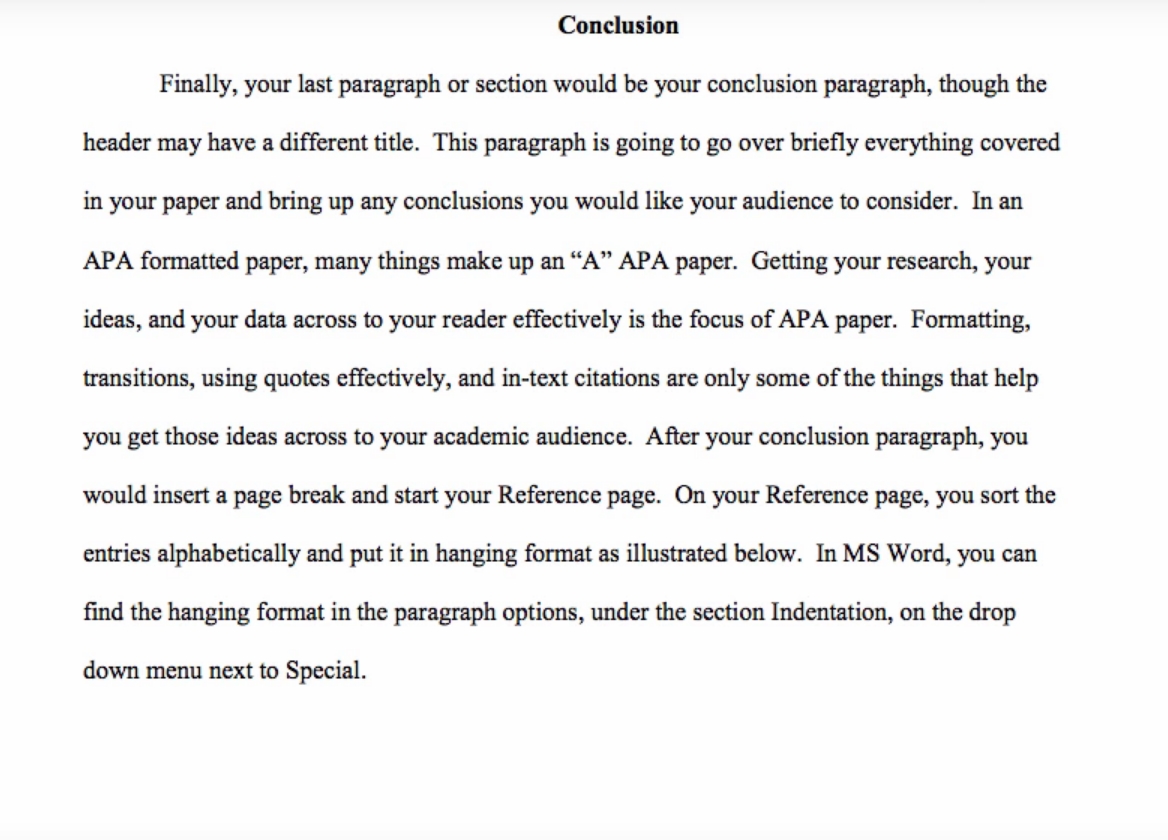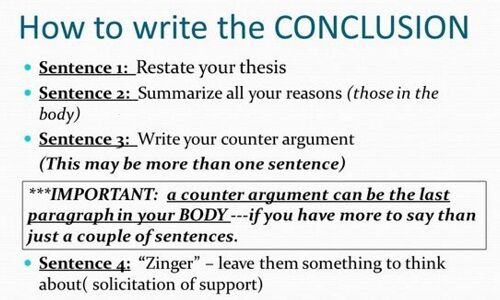
Let’s look at how to start a conclusion for a research paper: Briefly restate the topic. Rephrase the thesis statement. Summarize your main points in brief. A call to action where appropriate · How to Make Your Conclusion More Effective? Make a short description of each section. You should also make a brief description of every section of your work. Such a simple advice is very Read all your tasks. Keep things together. Stop drinking coffee - order a paper and · However, the importance of a good conclusion for a research paper can hardly be overrated. It’s true that the primary goal of the research is to summarize the paper, but the truth is that it’s much more complex than a simple summary of the work
How To Start A Conclusion Paragraph That Makes A Good Impression
Last Updated: March 19, References Approved. This article was co-authored by Christopher Taylor, PhD. Christopher Taylor is an Adjunct Assistant Professor of English at Austin Community College in Texas. He received his PhD in English Literature and Medieval Studies from the University of Texas at Austin in There are 11 references cited in this article, which can be found at the bottom of the page.
wikiHow marks an article as reader-approved once it receives enough positive feedback. This article has been viewed 2, times. The conclusion of a research paper needs to summarize the content and purpose of the paper without seeming too wooden or dry. Every basic conclusion must share several key elements, but there are also several tactics you can play around with to craft a more effective conclusion and several you should avoid to prevent yourself from weakening your paper's conclusion. Here are some writing tips to keep in mind when creating a conclusion for your next research paper.
To write a conclusion for a research paper, start by restating your thesis statement to remind your readers what your main topic is and bring everything full circle. Then, briefly summarize all of the main points you made throughout your paper, which will help remind your readers of everything they learned. You might also want to include a call to action if you think more research or work needs to be done on your topic by writing something like, "Despite efforts to contain the disease, more research is needed to develop antibiotics.
For tips from our Academic co-author, like how to avoid common pitfalls when writing your conclusion, how to start a conclusion for a research paper, scroll down! Did this summary help you? Yes No. Log in Social login does not work in incognito and private browsers. Please log in with your username or email to continue.
wikiHow Account. No account yet? Create an account. Community Dashboard Write an Article Request a New Article More Ideas Edit this Article.
Courses New Tech Help New Expert Videos About wikiHow Pro Upgrade Sign In. Home Random Browse Articles Courses New About wikiHow Easy Ways to Help Approve Questions Fix Spelling Quiz App More Things to Try We use cookies to make wikiHow great.
By using our site, you agree to our cookie policy. Cookie Settings. wikiHow is where trusted research and expert knowledge come together. Learn why people trust wikiHow. Categories Education and Communications College University and Postgraduate Academic Writing Essays Research Papers How to Write a Conclusion for a Research Paper. Download Article Explore this Article parts. Sample Conclusions. Related Articles. Article Summary.
Co-authored by Christopher Taylor, PhD Last Updated: March 19, References Approved. Sample Conclusions Sample Conclusion for History Paper.
Support wikiHow and unlock all samples. Part 1 of Restate the topic. You should briefly restate the topic as well as explaining why it is important. A good research paper will make the importance of your topic apparent, so you do not need to write an elaborate defense of your topic in the conclusion. Usually a single sentence is all you need to restate your topic.
An example would be if you were writing a paper on the epidemiology of an infectious disease, you might say something like "Tuberculosis is a widespread infectious disease that affects millions of people worldwide every year. Restate your thesis. Aside from the topic, you should also restate or rephrase your thesis statement.
This statement should be rephrased from the thesis you included in your introduction. It should not be identical or too similar to the sentence you originally used. Try re-wording your thesis statement in a way that complements your summary of the topic of your paper in your first sentence of your conclusion.
An example of a good thesis statement, going back to the paper on tuberculosis, would be "Tuberculosis is a widespread disease that affects millions of people worldwide every year.
Due to the alarming rate of the spread of tuberculosis, particularly in poor countries, medical professionals are implementing new strategies for the diagnosis, treatment, and containment of this disease. Briefly summarize your main points. Essentially, you need to remind your reader what you told them in the body of the paper.
Find a way to briefly restate each point mentioned in each topic sentence in your conclusion. Do not repeat any of the supporting details used within your body paragraphs. Under most circumstances, you should avoid writing new information in your conclusion.
This is especially true if the information is vital to the argument or research presented in your paper. For example, in the TB paper you could summarize the information. In developing countries, such as those in Africa and Southeast Asia, the rate of TB infections is soaring, how to start a conclusion for a research paper.
Crowded conditions, poor sanitation, and lack of access to medical care are all compounding factors in the spread of the disease.
Medical experts, such as those from the World Health Organization are now starting campaigns to go into communities in developing countries and provide diagnostic testing and treatments. However, the treatments for TB are very harsh and have many side effects. This leads to patient non-compliance and spread of multi-drug resistant strains of the disease, how to start a conclusion for a research paper.
Add the points up. If your paper proceeds in an how to start a conclusion for a research paper manner and you have not fully explained the significance of your points yet, you need to do so in your conclusion. How to start a conclusion for a research paper you already fully explained what the points in your paper mean or why they are significant, you do not need to go into them in much detail in your conclusion.
Simply restating your thesis or the significance of your topic should suffice. It is always best practice to address important issues and fully explain your points in the body of your paper. The point of a conclusion to a research paper is to summarize your argument for the reader and, perhaps, to call the reader to action if needed. Make a call to action when appropriate. If and when needed, you can state to your readers that there is a need for further research on your paper's topic.
Note that a call for action is not essential to all conclusions. A research paper on literary criticism, for instance, is less likely to need a call for action than a paper on the effect that television has on toddlers and young children.
A paper that is more likely to call readers to action is one that addresses a public or scientific need. Let's go back to our example of tuberculosis.
This is a very serious disease that is spreading quickly and with antibiotic-resistant forms. A call to action in this research paper would be a follow-up statement that might be along the lines of "Despite new efforts to diagnose and contain the disease, more research is needed to develop new antibiotics that will treat the most resistant strains of tuberculosis how to start a conclusion for a research paper ease the side effects of current treatments.
The conclusion of a paper is your opportunity to explain the broader context of the issue you have been discussing. It is also a place to help readers understand why the topic of your paper truly matters. For example, if you are writing a history paper, then you might discuss how the historical topic you discussed matters today.
If you are writing about a foreign country, then you might use the conclusion to discuss how the information you shared may help readers understand their own country. Part 2 of Stick with a basic synthesis of information. The most basic conclusion is the summary closing, which is very similar to the paper's how to start a conclusion for a research paper. Since this sort of conclusion is so basic, you must aim to synthesize the information rather than merely summarizing it, how to start a conclusion for a research paper.
Instead of merely repeating things you already said, rephrase your thesis and supporting points in a way that ties them all together. By doing so, you make your research paper seem like a "complete thought" rather than a collection of random and vaguely related ideas. Bring things full circle. There are several ways to do this. Ask a question in your introduction.
In your conclusion, restate the question and provide a direct answer. Write an anecdote or story in your introduction but do not share the ending. Instead, write the conclusion to the anecdote in the conclusion of your paper. For example, if you wanted to get more creative and put a more humanistic spin on a paper on tuberculosis, you might start your introduction with a story about a person with the disease, and refer to that story in your conclusion.
For example, you could say something like this before you re-state your thesis in your conclusion: "Patient X was unable to complete the treatment for tuberculosis due to severe side effects and unfortunately succumbed to the disease. The images may or may not appear at other points throughout the research paper. Close with logic. If your research paper presented multiple sides of an issue, use your conclusion to state a logical opinion formed by your evidence.
Include enough information about your topic to back the statement up but do not get too carried away with excess detail.
How to Write a Conclusion for a Dissertation - Scribbr ��
, time: 4:16How to Write a Research Paper Conclusion: Tips & Examples

· However, the importance of a good conclusion for a research paper can hardly be overrated. It’s true that the primary goal of the research is to summarize the paper, but the truth is that it’s much more complex than a simple summary of the work A conclusion for a research paper should follow a specific style, which is a bit different from the rest of the essay parts. However, the tone of the entire work should be the same. We suggest that you memorize these general rules for a conclusion · How to Make Your Conclusion More Effective? Make a short description of each section. You should also make a brief description of every section of your work. Such a simple advice is very Read all your tasks. Keep things together. Stop drinking coffee - order a paper and
No comments:
Post a Comment